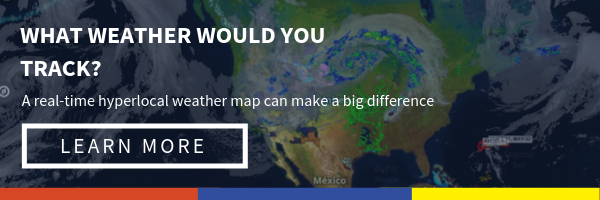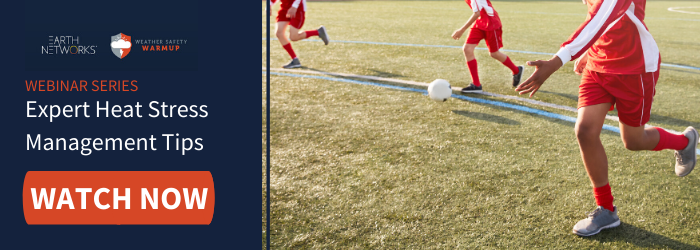What Is Wet Bulb Globe Temperature (WBGT)?
Wet bulb globe temperature (WBGT). Say that three times fast!
It’s difficult to say and isn’t easy to calculate, but monitoring wet bulb globe temperature is a stress-free way to protect student athletes, employees, and overall operations from extreme heat.
Wet bulb globe temperature (WBGT) is a popular topic for schools, employers, and sports leagues around the world. Schools, athletic programs, and manual labor organizations look at wet bulb globe temperature as a comprehensive measure of all the weather-related factors that impact bodies (and performance).
So, what is the wet bulb globe temperature and how can you use it? It’s time to become a WBGT expert so you can see why it is the best way to measure heat and manage heat stress for your organization and how you can go about doing that.
What is Wet Bulb Globe Temperature (WBGT)?
According to the National Weather Service, wet bulb globe temperature (WBGT) is an apparent measurement used to estimate the most accurate level of heat stress in direct sunlight. It’s quicker to refer to it as WBGT but they mean the same thing.
What about WBGT vs. temperature or WBGT vs. Heat Index?
Well, temperature is just the reading on the thermometer. So it’s the most basic reading for heat. Heat index considers two factors: Temperature and humidity. So, heat index is a little more comprehensive but still misses a lot.
On the other hand, WBGT takes five factors into account. These include:

![]() Temperature
Temperature
![]() Humidity
Humidity
![]() Wind speed
Wind speed
![]() Sun angle
Sun angle
![]() Cloud cover (solar radiation)
Cloud cover (solar radiation)
This helps produce the most accurate temperature readings. With WBGT, groups like military agencies, industrial hygienists, and sports programs can manage their workloads effectively and optimize performance in high-temperature environments.
How is Wet Bulb Globe Temperature Calculated?
As we mentioned before, WBGT takes several environmental factors into account. Because of this, there is a mathematical equation that includes all the pertinent factors when calculating WBGT. The equation is: WBGT = 0.7 Tw + 0.2 Tg + 0.1 Td

Let’s break it down.
![]() The first variable is Tw, or the natural wet bulb temperature, which indicates humidity
The first variable is Tw, or the natural wet bulb temperature, which indicates humidity
![]() Next is Tg, or the globe thermometer temperature, which indicates radiant heat
Next is Tg, or the globe thermometer temperature, which indicates radiant heat
![]() Finally Td is the dry bulb temperature, which indicates ambient air temperature
Finally Td is the dry bulb temperature, which indicates ambient air temperature
That’s it! It’s important to note that there is a different equation for calculating WBGT indoors or when solar radiation is negligible. You probably won’t need that equation. If you’re wondering what that equation is our friends at the Korey Stringer Institute have it on their website.
What About Wet Bulb Temperature?
While wet bulb globe temperature is a calculation that helps us discover how heat affects the human body, there is a different measurement called wet bulb temperature. What is the wet bulb temperature?
Wet bulb temperature is a measurement taken by a thermometer that has a bulb covered by a water-soaked cloth. When air passes over the cloth to evaporate the water, the evaporative cooling shows the wet bulb temperature on the thermometer.
But why do we care about this measurement? We often use this temperature to find the dew point and/or humidity as we compare it to the dry bulb air temperature.
If you’re a Sferic Maps user, you can access hyperlocal wet bulb globe temperatures and the WBGT 10 minute average. You can check out how to use these layers in the video below.
WBGT History
When did temperature and heat index stop being enough?
Some of the earliest users of WBGT were the U.S. Marines and U.S. Army. These branches of the military used WBGT to help drill sergeants and officers know how hard they could push recruits during outdoor activities while avoiding heat illness. They created activity level/rest time ratios based on WBGT to maximize training results.
They developed a flag system for training areas. The flag colors let officers know the WBGT status. White flags are Category 1, Green are Category 2, Yellow are Category 3, Red are Category 4, and Black are Category 5.

Over the years other groups began using WBGT and created their own guidelines. Some of the most popular reference groups today include:
- The American College of Sports Medicine (ACSM) Guidelines
- Georgia State High School Guidelines
- National Athletic Trainers Association (NATA) Guidelines
- North Carolina State High School Guidelines
- Vermont State High School Guidelines
- New Jersey High School Guidelines
- TB Med 507 (Military) Guidelines
- American Conference of Governmental Industrial Hygienists (ACGIH) Guidelines (Industrial)
- Industrial Health (Southeast Asia) Guidelines
- Ministry of the Environment (Japan) Guidelines
Heat Acclimatization

Each category includes water intake guides for both heat acclimated and unacclimated individuals.
What is heat acclimatization? Let’s review for those of you who are not familiar or just need a refresher.
Heat acclimatization is the process of adjusting one’s body to high-temperature conditions.
This process lowers the possibility of heat illness or exertional heat stroke (EHS). This improves overall outdoor performance in athletes and laborers. If properly done, heat acclimatization can lower your heart rate, reduce body and skin temperature responses, and increase sweat production and blood flow.
For athletics, begin heat acclimatization early in the season by slowly and steadily introducing heat stress to the body. This can mean lengthening workouts and exposure a little each day, adjusting your heart rate under stress, wearing limited gear and more. Other steps toward acclimatization in athletics include:
![]() Do not practice longer than 3 hours per day
Do not practice longer than 3 hours per day
![]() No consecutive double practices
No consecutive double practices
![]() Increase workout intensity gradually over a few days
Increase workout intensity gradually over a few days
![]() Increase sodium intake as sweat increases
Increase sodium intake as sweat increases
![]() Hydrate regularly throughout games and practices
Hydrate regularly throughout games and practices
![]() Take frequent rests to avoid overheating
Take frequent rests to avoid overheating
You can learn more about heat acclimatization and how to keep people safe from Dr. Doug Casa and the experts at the Korey Stringer Institute (KSI). The leading experts on WBGT, KSI sat down with us for an hour-long webinar about heat stress management. We recorded the webinar so everyone could have a chance to watch it! Click the link below to become a WBGT expert.
What is the Purpose of Wet Bulb Globe Temperature? 🏃♀️

Wet bulb globe temperature may just seem like another way to read the thermometer or an annoying stipulation to keep you from conditioning student-athletes. However, the real purpose of using the wet bulb globe temperature is to make your team healthier and better prepared to perform in high heat situations.
The real purpose of using wet bulb globe temperature as a heat measurement is to keep people safe while performing strenuous outdoor activities at high temperature.
It is the most comprehensive and therefore most reliable measure of how hard or easy it is for athletes to perform in their specific outdoor environment.
Athletic Directors, Athletic Trainers, Coaches, Recreation Managers and players themselves use wet bulb globe temperature to help with heat acclimatization during warmer months to prevent heat-related illnesses and injuries by adjusting their activities accordingly.
Suggested Actions and Impact Prevention
So how are the WBGT guidelines broken down? According to the National Weather Service (NWS), There are four main categories of WBGT. Each category comes with its own effects and suggested actions for outdoor activity. These categories don’t start until the WBGT hits 80 degrees F.
Remember, when we refer to temperature here, we are referring to WBGT.

When it’s 80-85 degrees F (in WBGT), working or exercising in direct sunlight will stress an individual’s body after 45 minutes. To prevent heat illness and lessen the overall impact of heat stress, plan 15 minutes of breaks for each hour you’re out in direct sunlight.
When it’s 85-88 degrees F (in WBGT) your body will stress from working or exercising in direct sunlight after just 30 minutes. Since your body stresses quicker, you’ll need longer breaks. If the WBGT is in this category make sure you take at least 30-minute breaks.
When it’s 88-90 degrees F your body will stress from just 20 minutes of working in direct sunlight. Take at least 40 minutes of breaks. For coaches this may seem a little extreme, but you can use the shaded break times to go over strategy and other critical concepts.
If the WBGT is 90 degrees F or above working or exercising in direct sunlight will stress your body in just 15 minutes. That means breaks increase to 45 minutes for each hour working in direct sunlight. You may benefit from moving practice indoors at this point. Make sure you keep a close eye on both acclimated and unacclimated athletes.
Breaks
Take all breaks in the shade. If there is no natural shade in the area surrounding your strenuous outdoor activity, improvise with pop-up tents. Shade has a tremendous effect on lowering the heat stress levels. That’s because it’s often 10-15 degrees cooler in the shade. Even 10 degrees will make a huge difference to someone on the verge of heat illness.
Hydration
Make sure those exerting themselves in high temperature environments are drinking plenty of water. Bodies need water to help keep them cool. Remind athletes to drink water even when they aren’t thirsty. Also advise them to increase water intake with increased time outdoors. Sports drinks with sodium and electrolytes are also key in replacing nutrients we sweat out. Athletes and outdoor workers alike should always take in more water than they are losing or dehydration is unavoidable.
Sunscreen
One last suggested action when using WBGT guidelines is to reduce sun exposure. You can do this with sunscreen, proper clothing, and hats (when possible).
The best way to reduce sun exposure in athletes is by planning outdoor activities in the early morning or evening. Before 10 a.m. and after 4 p.m. are the best times for reduced sunlight exposure. Athletes should also wear a waterproof/sweat proof sunscreen. This sunscreen should have a SPF of at least 30. It should also have broad spectrum protection (against both UVA and UVB rays).
We’ve found that stick formula suncreens are good for faces because the sunscreen stays out of your eyes even if you sweat. Athletes should apply sunscreen at least 20 minutes before they head out into the sun. Ensure they reapply every two hours or after excessively sweating.
Monitoring WBGT
To put the suggested actions and impact prevention plans into effect, you must measure WBGT at your facility. There are a few monitoring and alerting methods, devices, and services you can use to protect athletes at your facility.
Manually Calculating WBGT
If you don’t have a physical WBGT device or an alerting service from a trusted real-time weather data provider, you can use a chart (like the one provided below) to estimate wet bulb globe temperature using a combination of the current temperature and relative humidity. As this is just an estimate, we do not recommend this as a foolproof WBGT monitoring method.

Handheld Monitoring Devices
That brings us to other methods of monitoring WBGT. To get a more accurate reading of this life-saving temperature measurement, you can use a handheld monitoring device. There are plenty of different models on the market today for you to choose from. However, it’s important to note that these devices can fluctuate in accuracy and may require calibration and maintenance. In addition, the measurement stays with one person rather than being available to a team. Another drawback to relying on handheld WBGT devices is human error, which is quite common.
On-Site Weather Station
The final way to monitor WBGT at your facility is from a hyperlocal weather station network that measures and forecasts it.
Our weather stations measure WBGT as a current condition from a station level. This condition can then be monitored in our Sferic Maps weather map or Sferic Mobile application. Earth Networks professional grade weather stations also provide wet bulb globe temperature forecasting and a 10-minute WBGT average. This ensures that weather station locations know:
- The current wet bulb globe temperature
- The forecast wet bulb globe temperature
- Hisotrical wet bulb globe temperatures
You can trust professional weather networks because they calibrate weather data to ensure its factually correct. Automated WBGT category alerts via text or email ensure everyone is in the know as quickly as possible and prepared to activate their impact prevention protocol.
WBGT: The Bottom Line
So what does all this mean?
WBGT is the number one way to keep student-athletes (or anyone exerting themselves outdoors) safe from heat illness. That means it’s better than just monitoring the temperature or heat index.
![]() Wet bulb globe provides an accurate measurement of environmental heat stress
Wet bulb globe provides an accurate measurement of environmental heat stress
![]() It’s been around for over 60 years
It’s been around for over 60 years
![]() You can use WBGT as a preventative measure to reduce heat illnesses by modifying work/rest ratios
You can use WBGT as a preventative measure to reduce heat illnesses by modifying work/rest ratios
![]() WBGT modifications vary for acclimated and unacclimated individuals
WBGT modifications vary for acclimated and unacclimated individuals
![]() WBGT is a more comprehensive heat stress measure than temperature or Heat Index
WBGT is a more comprehensive heat stress measure than temperature or Heat Index
![]() Automatic WBGT warnings based on real-time readings are the easiest and quickest form of monitoring and alerting method
Automatic WBGT warnings based on real-time readings are the easiest and quickest form of monitoring and alerting method
When wet bulb globe temperature goes up against temperature or heat index, it always wins as the best tool to help you and your athletes have a successful and safe season.
Now What?
Now that you’re a regular wet bulb globe temperature expert it’s time to think about how you might be able to use this measurement in your life.
If you’re a coach, athletic director, or athletic trainer you can provide safer heat stress guidelines, faster heat illness response, and increase the wellness of all your student athletes.
It’s time to start thinking about monitoring and alerting on WBGT at your school.
Click the button below to learn how to get real-time alerts for WBGT and other severe weather threats at your school:







